Hubble Space Telescope
| |||||
| Mission type | Astronomy | ||||
|---|---|---|---|---|---|
| Operator | NASA · ESA · STScI | ||||
| COSPAR ID | 1990-037B | ||||
| SATCAT № | 20580 | ||||
| Website | nasa hubblesite spacetelescope | ||||
| Mission duration | Elapsed: 26 years, 4 months and 28 days | ||||
| Spacecraft properties | |||||
| Manufacturer | Lockheed (spacecraft) Perkin-Elmer (optics) | ||||
| Launch mass | 11,110 kg (24,490 lb) | ||||
| Dimensions | 13.2 × 4.2 m (43 × 14 ft) | ||||
| Power | 2,800 watts | ||||
| Start of mission | |||||
| Launch date | April 24, 1990, 12:33:51 UTC | ||||
| Rocket | Space Shuttle Discovery (STS-31) | ||||
| Launch site | Kennedy LC-39B | ||||
| Deployment date | April 25, 1990 | ||||
| Entered service | May 20, 1990 | ||||
| End of mission | |||||
| Decay date | estimated 2030–2040 | ||||
| Orbital parameters | |||||
| Reference system | Geocentric | ||||
| Regime | Low Earth | ||||
| Semi-major axis | 6,919.9 km (4,299.8 mi) | ||||
| Eccentricity | 0.000284 | ||||
| Perigee | 539.8 km (335.4 mi) | ||||
| Apogee | 543.7 km (337.8 mi) | ||||
| Inclination | 28.47° | ||||
| Period | 95.48 min | ||||
| RAAN | 326.13° | ||||
| Argument of perigee | 11.39° | ||||
| Mean anomaly | 83.01° | ||||
| Mean motion | 15.08 rev/day | ||||
| Velocity | 7.59 km/s (4.72 mi/s) | ||||
| Epoch | February 18, 2016, 22:26:51 UTC | ||||
| Revolution number | 21,700 | ||||
| Main telescope | |||||
| Type | Ritchey–Chrétien reflector | ||||
| Diameter | 2.4 m (7.9 ft) | ||||
| Focal length | 57.6 m (189 ft) | ||||
| Collecting area | 4.5 m2 (48 sq ft) | ||||
| Wavelengths | Near-infrared, visible light, ultraviolet | ||||
With a 2.4-meter (7.9 ft) mirror, Hubble's four main instruments observe in the near ultraviolet, visible, and near infrared spectra. Hubble's orbit outside the distortion of Earth's atmosphere allows it to take extremely high-resolution images, with substantially lower background light than ground-based telescopes. Hubble has recorded some of the most detailed visible light images ever, allowing a deep view into space and time. Many Hubble observations have led to breakthroughs in astrophysics, such as accurately determining the rate of expansion of the universe.
The HST was built by the United States space agency NASA, with contributions from the European Space Agency. The Space Telescope Science Institute (STScI) selects Hubble's targets and processes the resulting data, while the Goddard Space Flight Center controls the spacecraft.
Space telescopes were proposed as early as 1923. Hubble was funded in the 1970s, with a proposed launch in 1983, but the project was beset by technical delays, budget problems, and the Challenger disaster (1986). When finally launched in 1990, Hubble's main mirror was found to have been ground incorrectly, compromising the telescope's capabilities. The optics were corrected to their intended quality by a servicing mission in 1993.
Hubble is the only telescope designed to be serviced in space by astronauts. After launch by Space Shuttle Discovery in 1990, four subsequent Space Shuttle missions repaired, upgraded, and replaced systems on the telescope. A fifth mission was canceled on safety grounds following the Columbia disaster (2003). However, after spirited public discussion, NASA administrator Mike Griffin approved one final servicing mission, completed in 2009. The telescope is operating as of 2016, and could last until 2030–2040. Its scientific successor, the James Webb Space Telescope (JWST), is scheduled for launch in 2018.
Conception, design and aim
Proposals and precursors
In 1923, Hermann Oberth—considered a father of modern rocketry, along with Robert H. Goddard and Konstantin Tsiolkovsky—published Die Rakete zu den Planetenräumen ("The Rocket into Planetary Space"), which mentioned how a telescope could be propelled into Earth orbit by a rocket.The history of the Hubble Space Telescope can be traced back as far as 1946, to the astronomer Lyman Spitzer's paper "Astronomical advantages of an extraterrestrial observatory". In it, he discussed the two main advantages that a space-based observatory would have over ground-based telescopes. First, the angular resolution (the smallest separation at which objects can be clearly distinguished) would be limited only by diffraction, rather than by the turbulence in the atmosphere, which causes stars to twinkle, known to astronomers as seeing. At that time ground-based telescopes were limited to resolutions of 0.5–1.0 arcseconds, compared to a theoretical diffraction-limited resolution of about 0.05 arcsec for a telescope with a mirror 2.5 m in diameter. Second, a space-based telescope could observe infrared and ultraviolet light, which are strongly absorbed by the atmosphere.
Spitzer devoted much of his career to pushing for the development of a space telescope. In 1962, a report by the US National Academy of Sciences recommended the development of a space telescope as part of the space program, and in 1965 Spitzer was appointed as head of a committee given the task of defining scientific objectives for a large space telescope.
Space-based astronomy had begun on a very small scale following World War II, as scientists made use of developments that had taken place in rocket technology. The first ultraviolet spectrum of the Sun was obtained in 1946, and the National Aeronautics and Space Administration (NASA) launched the Orbiting Solar Observatory (OSO) to obtain UV, X-ray, and gamma-ray spectra in 1962. An orbiting solar telescope was launched in 1962 by the United Kingdom as part of the Ariel space program, and in 1966 NASA launched the first Orbiting Astronomical Observatory (OAO) mission. OAO-1's battery failed after three days, terminating the mission. It was followed by OAO-2, which carried out ultraviolet observations of stars and galaxies from its launch in 1968 until 1972, well beyond its original planned lifetime of one year.
The OSO and OAO missions demonstrated the important role space-based observations could play in astronomy, and in 1968, NASA developed firm plans for a space-based reflecting telescope with a mirror 3 m in diameter, known provisionally as the Large Orbiting Telescope or Large Space Telescope (LST), with a launch slated for 1979. These plans emphasized the need for manned maintenance missions to the telescope to ensure such a costly program had a lengthy working life, and the concurrent development of plans for the reusable space shuttle indicated that the technology to allow this was soon to become available.
Quest for funding
The continuing success of the OAO program encouraged increasingly strong consensus within the astronomical community that the LST should be a major goal. In 1970, NASA established two committees, one to plan the engineering side of the space telescope project, and the other to determine the scientific goals of the mission. Once these had been established, the next hurdle for NASA was to obtain funding for the instrument, which would be far more costly than any Earth-based telescope. The U.S. Congress questioned many aspects of the proposed budget for the telescope and forced cuts in the budget for the planning stages, which at the time consisted of very detailed studies of potential instruments and hardware for the telescope. In 1974, public spending cuts led to Congress deleting all funding for the telescope project.In response to this, a nationwide lobbying effort was coordinated among astronomers. Many astronomers met congressmen and senators in person, and large scale letter-writing campaigns were organized. The National Academy of Sciences published a report emphasizing the need for a space telescope, and eventually the Senate agreed to half of the budget that had originally been approved by Congress.
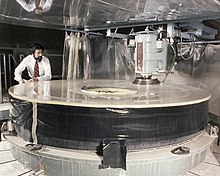 |
Grinding of Hubble's primary mirror at Perkin-Elmer, March 1979 |
Construction and engineering
Once the Space Telescope project had been given the go-ahead, work on the program was divided among many institutions. Marshall Space Flight Center (MSFC) was given responsibility for the design, development, and construction of the telescope, while Goddard Space Flight Center was given overall control of the scientific instruments and ground-control center for the mission.MSFC commissioned the optics company Perkin-Elmer to design and build the Optical Telescope Assembly (OTA) and Fine Guidance Sensors for the space telescope. Lockheed was commissioned to construct and integrate the spacecraft in which the telescope would be housed.Optical Telescope Assembly (OTA)
Optically, the HST is a Cassegrain reflector of Ritchey–Chrétien design, as are most large professional telescopes. This design, with two hyperbolic mirrors, is known for good imaging performance over a wide field of view, with the disadvantage that the mirrors have shapes that are hard to fabricate and test. The mirror and optical systems of the telescope determine the final performance, and they were designed to exacting specifications. Optical telescopes typically have mirrors polished to an accuracy of about a tenth of the wavelength of visible light, but the Space Telescope was to be used for observations from the visible through the ultraviolet (shorter wavelengths) and was specified to be diffraction limited to take full advantage of the space environment. Therefore, its mirror needed to be polished to an accuracy of 10 nanometers, or about 1/65 of the wavelength of red light. On the long wavelength end, the OTA was not designed with optimum IR performance in mind—for example, the mirrors are kept at stable (and warm, about 15 °C) temperatures by heaters. This limits Hubble's performance as an infrared telescope.The backup mirror, by Kodak; its inner support structure can be seen because it is not coated with a reflective surface. |
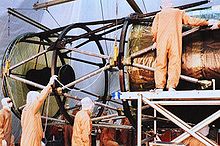 |
The OTA, metering truss, and secondary baffle are visible in this image of Hubble during early construction. |
Spacecraft systems
The spacecraft in which the telescope and instruments were to be housed was another major engineering challenge. It would have to withstand frequent passages from direct sunlight into the darkness of Earth's shadow, which would cause major changes in temperature, while being stable enough to allow extremely accurate pointing of the telescope. A shroud of multi-layer insulation keeps the temperature within the telescope stable, and surrounds a light aluminum shell in which the telescope and instruments sit. Within the shell, a graphite-epoxy frame keeps the working parts of the telescope firmly aligned. Because graphite composites are hygroscopic, there was a risk that water vapor absorbed by the truss while in Lockheed's clean room would later be expressed in the vacuum of space; resulting in the telescope's instruments being covered by ice. To reduce that risk, a nitrogen gas purge was performed before launching the telescope into space.While construction of the spacecraft in which the telescope and instruments would be housed proceeded somewhat more smoothly than the construction of the OTA, Lockheed still experienced some budget and schedule slippage, and by the summer of 1985, construction of the spacecraft was 30% over budget and three months behind schedule. An MSFC report said that Lockheed tended to rely on NASA directions rather than take their own initiative in the construction.
Computer systems and data processing
The two initial, primary computers on the HST were the 1.25 MHz DF-224 system, built by Rockwell Autonetics, which contained three redundant CPUs, and two redundant NSSC-1 (NASA Standard Spacecraft Computer, Model 1) systems, developed by Westinghouse and GSFC using diode-transistor logic (DTL). A co-processor for the DF-224 was added during Servicing Mission 1 in 1993, which consisted of two redundant strings of an Intel-based 80386 processor with an 80387 math co-processor. The DF-224 and its 386 co-processor were replaced by a 25 MHz Intel-based 80486 processor system during Servicing Mission 3A in 1999.Additionally, some of the science instruments and components had their own embedded microprocessor-based control systems. The MATs (Multiple Access Transponder) components, MAT-1 and MAT-2, utilize Hughes Aircraft CDP1802CD microprocessors. The Wide Field and Planetary Camera (WFPC) also utilized an RCA 1802 microprocessor (or possibly the older 1801 version). The WFPC-1 was replaced by the WFPC-2 during Servicing Mission 1 in 1993, which was then replaced by the Wide Field Camera 3 (WFC3) during Servicing Mission 4 in 2009.
Initial instruments
 |
Exploded view of the Hubble Space Telescope |
The GHRS was a spectrograph designed to operate in the ultraviolet. It was built by the Goddard Space Flight Center and could achieve a spectral resolution of 90,000. Also optimized for ultraviolet observations were the FOC and FOS, which were capable of the highest spatial resolution of any instruments on Hubble. Rather than CCDs these three instruments used photon-counting digicons as their detectors. The FOC was constructed by ESA, while the University of California, San Diego, and Martin Marietta Corporation built the FOS.
The final instrument was the HSP, designed and built at the University of Wisconsin–Madison. It was optimized for visible and ultraviolet light observations of variable stars and other astronomical objects varying in brightness. It could take up to 100,000 measurements per second with a photometric accuracy of about 2% or better.
HST's guidance system can also be used as a scientific instrument. Its three Fine Guidance Sensors (FGS) are primarily used to keep the telescope accurately pointed during an observation, but can also be used to carry out extremely accurate astrometry; measurements accurate to within 0.0003 arcseconds have been achieved.
Ground support
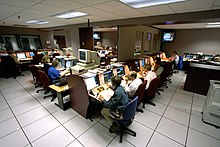 |
Hubble Control Center at Goddard Space Flight Center, 1999 |
 |
Hubble's low orbit means many targets are visible for somewhat less than half of an orbit's elapsed time, since they are blocked from view by the Earth for one-half of each orbit. |
Hubble orbits in the upper atmosphere at an altitude of approximately 569 kilometers (354 mi) and an inclination of 28.5°. The position along its orbit changes over time in a way that is not accurately predictable. The density of the upper atmosphere varies according to many factors, and this means that Hubble's predicted position for six weeks' time could be in error by up to 4,000 km (2,500 mi). Observation schedules are typically finalized only a few days in advance, as a longer lead time would mean there was a chance that the target would be unobservable by the time it was due to be observed.
Engineering support for HST is provided by NASA and contractor personnel at the Goddard Space Flight Center in Greenbelt, Maryland, 48 km (30 mi) south of the STScI. Hubble's operation is monitored 24 hours per day by four teams of flight controllers who make up Hubble's Flight Operations Team.
Challenger disaster, delays, and eventual launch
STS-31 lifts off, carrying Hubble into orbit. |
Eventually, following the resumption of shuttle flights in 1988, the launch of the telescope was scheduled for 1990. On April 24, 1990, shuttle mission STS-31 saw Discovery launch the telescope successfully into its planned orbit.
From its original total cost estimate of about US$400 million, the telescope had by now cost over $2.5 billion to construct. Hubble's cumulative costs were estimated to be about US$10 billion in 2010, twenty years after launch.
Flawed mirror
Within weeks of the launch of the telescope, the returned images indicated a serious problem with the optical system. Although the first images appeared to be sharper than those of ground-based telescopes, Hubble failed to achieve a final sharp focus and the best image quality obtained was drastically lower than expected. Images of point sources spread out over a radius of more than one arcsecond, instead of having a point spread function (PSF) concentrated within a circle 0.1 arcsec in diameter as had been specified in the design criteria.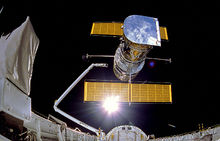 |
Hubble is deployed from Discovery in 1990. |
The effect of the mirror flaw on scientific observations depended on the particular observation—the core of the aberrated PSF was sharp enough to permit high-resolution observations of bright objects, and spectroscopy of point sources was only affected through a sensitivity loss. However, the loss of light to the large, out of focus halo severely reduced the usefulness of the telescope for faint objects or high-contrast imaging. This meant that nearly all of the cosmological programs were essentially impossible, since they required observation of exceptionally faint objects. NASA and the telescope became the butt of many jokes, and the project was popularly regarded as a white elephant. For instance, in the 1991 comedy The Naked Gun 2½: The Smell of Fear, Hubble was pictured with the Titanic, the Hindenburg, and the Edsel. Nonetheless, during the first three years of the Hubble mission, before the optical corrections, the telescope still carried out a large number of productive observations of less demanding targets. The error was well characterized and stable, enabling astronomers to partially compensate for the defective mirror by using sophisticated image processing techniques such as deconvolution.
Origin of the problem
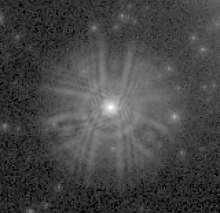 |
An extract from a WF/PC image shows the light from a star spread over a wide area instead of being concentrated on a few pixels |
The commission blamed the failings primarily on Perkin-Elmer. Relations between NASA and the optics company had been severely strained during the telescope construction, due to frequent schedule slippage and cost overruns. NASA found that Perkin-Elmer did not review or supervise the mirror construction adequately, did not assign its best optical scientists to the project (as it had for the prototype), and in particular did not involve the optical designers in the construction and verification of the mirror. While the commission heavily criticized Perkin-Elmer for these managerial failings, NASA was also criticized for not picking up on the quality control shortcomings, such as relying totally on test results from a single instrument.
Design of a solution
 |
The core of spiral galaxy M100, imaged with Hubble before and after corrective optics. |
The first step was a precise characterization of the error in the main mirror. Working backwards from images of point sources, astronomers determined that the conic constant of the mirror as built was −1.01390±0.0002, instead of the intended −1.00230. The same number was also derived by analyzing the null corrector used by Perkin-Elmer to figure the mirror, as well as by analyzing interferograms obtained during ground testing of the mirror.
 |
COSTAR on display at the National Air and Space Museum |
The Corrective Optics Space Telescope Axial Replacement (COSTAR) system was designed to correct the spherical aberration for light focused at the FOC, FOS, and GHRS. It consists of two mirrors in the light path with one ground to correct the aberration. To fit the COSTAR system onto the telescope, one of the other instruments had to be removed, and astronomers selected the High Speed Photometer to be sacrificed. By 2002, all of the original instruments requiring COSTAR had been replaced by instruments with their own corrective optics. COSTAR was removed and returned to Earth in 2009 where it is exhibited at the National Air and Space Museum. The area previously used by COSTAR is now occupied by the Cosmic Origins Spectrograph.
Servicing missions and new instruments

Servicing Mission 1
 |
Astronauts Musgrave and Hoffman install corrective optics during SM1 |
Most importantly, the High Speed Photometer was replaced with the COSTAR corrective optics package, and WFPC was replaced with the Wide Field and Planetary Camera 2 (WFPC2) with an internal optical correction system. The solar arrays and their drive electronics were also replaced, as well as four gyroscopes in the telescope pointing system, two electrical control units and other electrical components, and two magnetometers. The onboard computers were upgraded with added coprocessors, and Hubble's orbit was boosted.
On January 13, 1994, NASA declared the mission a complete success and showed the first sharper images. At the time, the mission was one of the most complex, involving five long extra-vehicular activity periods. Its success was a boon for NASA, as well as for the astronomers with a more capable space telescope.
Servicing Mission 2
 |
Hubble as seen from Discovery during its second servicing mission |
Servicing Mission 3A
Servicing Mission 3A, flown by Discovery, took place in December 1999, and was a split-off from Servicing Mission 3 after three of the six onboard gyroscopes had failed. The fourth failed a few weeks before the mission, rendering the telescope incapable of performing scientific observations. The mission replaced all six gyroscopes, replaced a Fine Guidance Sensor and the computer, installed a Voltage/temperature Improvement Kit (VIK) to prevent battery overcharging, and replaced thermal insulation blankets. The new computer is 20 times faster, with six times more memory, than the DF-224 it replaced. It increases throughput by moving some computing tasks from the ground to the spacecraft, and saves money by allowing the use of modern programming languages.Servicing Mission 3B
Servicing Mission 3B flown by Columbia in March 2002 saw the installation of a new instrument, with the FOC (which, except for the Fine Guidance Sensors when used for astrometry, was the last of the original instruments) being replaced by the Advanced Camera for Surveys (ACS). This meant that COSTAR was no longer required, since all new instruments had built-in correction for the main mirror aberration. The mission also revived NICMOS by installing a closed-cycle cooler and replaced the solar arrays for the second time, providing 30 percent more power.Servicing Mission 4
 |
Hubble during SM4 |
 |
Hubble after release |
SM4 installed the WFC3, which captured this image of the Butterfly Nebula. |
The nomination in April 2005 of a new NASA Administrator with an engineering rather than accounting background, Michael D. Griffin, changed the situation, as Griffin stated he would consider a manned servicing mission. Soon after his appointment Griffin authorized Goddard to proceed with preparations for a manned Hubble maintenance flight, saying he would make the final decision after the next two shuttle missions. In October 2006 Griffin gave the final go-ahead, and the 11-day mission by Atlantis was scheduled for October 2008. Hubble's main data-handling unit failed in September 2008, halting all reporting of scientific data until its back-up was brought online on October 25, 2008. Since a failure of the backup unit would leave the HST helpless, the service mission was postponed to incorporate a replacement for the primary unit.
Servicing Mission 4, flown by Atlantis in May 2009, was the last scheduled shuttle mission for HST. SM4 installed the replacement data-handling unit, repaired the ACS and STIS systems, installed improved nickel hydrogen batteries, and replaced other components. SM4 also installed two new observation instruments—Wide Field Camera 3 (WFC3) and the Cosmic Origins Spectrograph (COS)—and the Soft Capture and Rendezvous System, which will enable the future rendezvous, capture, and safe disposal of Hubble by either a crewed or robotic mission. Except for the High Resolution Channel of the ACS which was unable to be repaired, the work accomplished during SM4 rendered the telescope fully functional, and it remains so as of 2015.
Major projects
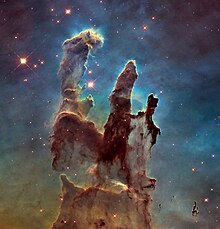 |
| One of Hubble's most famous images, "Pillars of Creation" shows stars forming in the Eagle Nebula |
Cosmic Assembly Near-infrared Deep Extragalactic Legacy Survey
In an August 2013 press release, CANDELS was referred to as "the largest project in the history of Hubble". The survey "aims to explore galactic evolution in the early Universe, and the very first seeds of cosmic structure at less than one billion years after the Big Bang." The CANDELS project site describes the survey's goals as the following:The Cosmic Assembly Near-IR Deep Extragalactic Legacy Survey is designed to document the first third of galactic evolution from z = 8 to 1.5 via deep imaging of more than 250,000 galaxies with WFC3/IR and ACS. It will also find the first Type Ia SNe beyond z > 1.5 and establish their accuracy as standard candles for cosmology. Five premier multi-wavelength sky regions are selected; each has multi-wavelength data from Spitzer and other facilities, and has extensive spectroscopy of the brighter galaxies. The use of five widely separated fields mitigates cosmic variance and yields statistically robust and complete samples of galaxies down to 109 solar masses out to z ~ 8.
Frontier Fields program
 |
The Frontier Fields program studied MACS0416.1-2403 |
- to reveal hitherto inaccessible populations of z = 5–10 galaxies that are 10 to 50 times fainter intrinsically than any presently known
- to solidify our understanding of the stellar masses and star formation histories of sub-L* galaxies at the earliest times
- to provide the first statistically meaningful morphological characterization of star forming galaxies at z > 5
- to find z > 8 galaxies stretched out enough by cluster lensing to discern internal structure and/or magnified enough by cluster lensing for spectroscopic follow-up.
Public use
 |
Star cluster Pismis 24 with nebula |
Calls for proposals are issued roughly annually, with time allocated for a cycle lasting about one year. Proposals are divided into several categories; "general observer" proposals are the most common, covering routine observations. "Snapshot observations" are those in which targets require only 45 minutes or less of telescope time, including overheads such as acquiring the target. Snapshot observations are used to fill in gaps in the telescope schedule that cannot be filled by regular GO programs.
Astronomers may make "Target of Opportunity" proposals, in which observations are scheduled if a transient event covered by the proposal occurs during the scheduling cycle. In addition, up to 10% of the telescope time is designated "director's discretionary" (DD) time. Astronomers can apply to use DD time at any time of year, and it is typically awarded for study of unexpected transient phenomena such as supernovae.
Other uses of DD time have included the observations that led to views of the Hubble Deep Field and Hubble Ultra Deep Field, and in the first four cycles of telescope time, observations that were carried out by amateur astronomers.
Amateur observations
The first director of STScI, Riccardo Giacconi, announced in 1986 that he intended to devote some of his director discretionary time to allowing amateur astronomers to use the telescope. The total time to be allocated was only a few hours per cycle but excited great interest among amateur astronomers. |
Near-infrared-light image from WFC3 of "Mystic Mountain" in the stellar nursery of Carina Nebula. More stars can be seen because of transparency to heat |
20th and 25th anniversaries
A pillar of gas and dust in the Carina Nebula. This Wide Field Camera 3 image, dubbed "Mystic Mountain", was released in 2010 to commemorate Hubble's 20th anniversary in space. |
To commemorate Hubble's 25th anniversary in space on April 24, 2015, STScI released images of the Westerlund 2 cluster, located about 20,000 light-years (6,100 pc) away in the constellation Carina, through its Hubble 25 website. The European Space Agency created a dedicated 25th anniversary page on its website.
Scientific results
Key projects
In the early 1980s, NASA and STScI convened four panels to discuss key projects. These were projects that were both scientifically important and would require significant telescope time, which would be explicitly dedicated to each project. This guaranteed that these particular projects would be completed early, in case the telescope failed sooner than expected. The panels identified three such projects: 1) a study of the nearby intergalactic medium using quasar absorption lines to determine the properties of the intergalactic medium and the gaseous content of galaxies and groups of galaxies; 2) a medium deep survey using the Wide Field Camera to take data whenever one of the other instruments was being used and 3) a project to determine the Hubble constant within ten percent by reducing the errors, both external and internal, in the calibration of the distance scale.Important discoveries
Hubble's STIS UV and ACS visible light are combined to reveal Saturn's southern aurora. |
Hubble has helped resolve some long-standing problems in astronomy, as well as raising new questions. Some results have required new theories to explain them. Among its primary mission targets was to measure distances to Cepheid variable stars more accurately than ever before, and thus constrain the value of the Hubble constant, the measure of the rate at which the universe is expanding, which is also related to its age. Before the launch of HST, estimates of the Hubble constant typically had errors of up to 50%, but Hubble measurements of Cepheid variables in the Virgo Cluster and other distant galaxy clusters provided a measured value with an accuracy of ±10%, which is consistent with other more accurate measurements made since Hubble's launch using other The estimated age is now about 13.7 billion years, but before the Hubble Telescope scientists predicted an age ranging from 10 to 20 billion years.
While Hubble helped to refine estimates of the age of the universe, it also cast doubt on theories about its future. Astronomers from the High-z Supernova Search Team and the Supernova Cosmology Project used ground-based telescopes and HST to observe distant supernovae and uncovered evidence that, far from decelerating under the influence of gravity, the expansion of the universe may in fact be accelerating. The cause of this acceleration remains poorly understood; the most common cause attributed is dark energy.
 |
Brown spots mark Comet Shoemaker–Levy 9 impact sites on Jupiter's southern hemisphere. Imaged by Hubble. |
The collision of Comet Shoemaker-Levy 9 with Jupiter in 1994 was fortuitously timed for astronomers, coming just a few months after Servicing Mission 1 had restored Hubble's optical performance. Hubble images of the planet were sharper than any taken since the passage of Voyager 2 in 1979, and were crucial in studying the dynamics of the collision of a comet with Jupiter, an event believed to occur once every few centuries.
Hubble Extreme Deep Field image of space in the constellation Fornax |
A unique window on the Universe enabled by Hubble are the Hubble Deep Field, Hubble Ultra-Deep Field, and Hubble Extreme Deep Field images, which used Hubble's unmatched sensitivity at visible wavelengths to create images of small patches of sky that are the deepest ever obtained at optical wavelengths. The images reveal galaxies billions of light years away, and have generated a wealth of scientific papers, providing a new window on the early Universe. The Wide Field Camera 3 improved the view of these fields in the infrared and ultraviolet, supporting the discovery of some of the most distant objects yet discovered, such as MACS0647-JD.
The non-standard object SCP 06F6 was discovered by the Hubble Space Telescope in February 2006. During June and July 2012, US astronomers using Hubble discovered a tiny fifth moon moving around icy Pluto.
In March 2015, researchers announced that measurements of aurorae around Ganymede revealed that the moon has a subsurface ocean. Using Hubble to study the motion of its aurorae, the researchers determined that a large saltwater ocean was helping to suppress the interaction between Jupiter's magnetic field and that of Ganymede. The ocean is estimated to be 100 km (60 mi) deep, trapped beneath a 150 km (90 mi) ice crust.
On December 11, 2015, Hubble captured an image of the first-ever predicted reappearance of a supernova, dubbed "Refsdal", which was calculated using different mass models of a galaxy cluster whose gravity is warping the supernova's light. The supernova was previously seen in November 2014 behind galaxy cluster MACS J1149.5+2223 as part of Hubble's Frontier Fields program. Astronomers spotted four separate images of the supernova in an arrangement known as an Einstein Cross. The light from the cluster has taken about five billion years to reach Earth, though the supernova exploded some 10 billion years ago. The detection of Refsdal's reappearance served as a unique opportunity for astronomers to test their models of how mass, especially dark matter, is distributed within this galaxy cluster.
On March 3, 2016, researchers using Hubble data announced the discovery of the farthest known galaxy to date: GN-z11. The Hubble observations occurred on February 11, 2015, and April 3, 2015, as part of the CANDELS/GOODS-North surveys.
Impact on astronomy
Evolution of detecting the early Universe |
Although the HST has clearly helped astronomical research, its financial cost has been large. A study on the relative astronomical benefits of different sizes of telescopes found that while papers based on HST data generate 15 times as many citations as a 4 m (13 ft) ground-based telescope such as the William Herschel Telescope, the HST costs about 100 times as much to build and maintain.
Deciding between building ground- versus space-based telescopes is complex. Even before Hubble was launched, specialized ground-based techniques such as aperture masking interferometry had obtained higher-resolution optical and infrared images than Hubble would achieve, though restricted to targets about 108 times brighter than the faintest targets observed by Hubble. Since then, advances in adaptive optics have extended the high-resolution imaging capabilities of ground-based telescopes to the infrared imaging of faint objects. The usefulness of adaptive optics versus HST observations depends strongly on the particular details of the research questions being asked. In the visible bands, adaptive optics can only correct a relatively small field of view, whereas HST can conduct high-resolution optical imaging over a wide field. Only a small fraction of astronomical objects are accessible to high-resolution ground-based imaging; in contrast Hubble can perform high-resolution observations of any part of the night sky, and on objects that are extremely faint.










